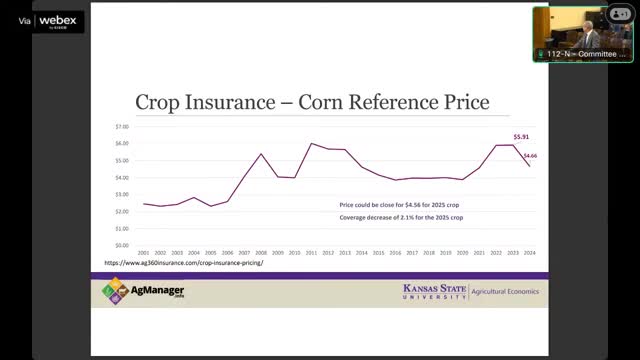Kansas farmers face declining safety nets and rising risks as crop prices drop
January 16, 2025 | Committee on Agriculture and Natural Resources, Standing, HOUSE OF REPRESENTATIVES, Committees, Legislative, Kansas
This article was created by AI summarizing key points discussed. AI makes mistakes, so for full details and context, please refer to the video of the full meeting. Please report any errors so we can fix them. Report an error »

In a recent meeting of the Kansas House Committee on Agriculture and Natural Resources, members gathered to discuss pressing issues affecting the state's agricultural landscape. The atmosphere was charged with concern as experts presented data revealing significant declines in safety net coverage for key crops, including corn, soybeans, and wheat.
Farmers are bracing for a challenging year ahead, with projections indicating a 2.1% decrease in safety net coverage for corn, a staggering 10% for soybeans, and a concerning 20% drop for wheat. This decline translates to increased risk for farmers, who may find themselves more vulnerable to market fluctuations and adverse weather conditions. While recent moisture and snow have reduced the immediate threat of drought, the potential for lower indemnities in the event of a drought looms large, given the decreased reference prices and guarantees.
The meeting also highlighted the troubling trend of falling commodity prices. Current cash bids for wheat stand at $4.80 per bushel, a stark contrast to $8.86 just two years ago. This downward trajectory in prices, coupled with rising costs, presents a daunting challenge for farmers trying to maintain profitability. Although recent USDA reports showed slight increases in soybean and corn prices, the overall outlook remains bleak.
Interest rates for farm credit have stabilized, with one-year loans at 4.2% and 30-year loans at 5.6%. These rates closely follow U.S. Treasury rates, providing a glimmer of hope for farmers seeking financing. Additionally, a notable decrease in nitrogen and fertilizer prices offers some relief, as these costs are closely tied to petroleum prices.
The American Relief Act of 2025 is expected to provide a much-needed boost to Kansas farmers, with estimates suggesting an average income of $45,000 per farm. This financial support could help alleviate some of the pressures faced by farmers, particularly as they navigate a landscape marked by fluctuating land values and working capital challenges.
Despite the difficulties, land values in Kansas have seen a remarkable increase over the past three years, rising by over 50%. This surge in land value is a positive sign for farmers, enhancing their overall wealth even if it does not directly translate to immediate cash flow.
As the committee wrapped up its discussions, the focus remained on the need for vigilance in monitoring debt levels and market conditions. With the agricultural sector facing a complex array of challenges, the insights shared during this meeting will be crucial for shaping future policies and support systems for Kansas farmers.
Farmers are bracing for a challenging year ahead, with projections indicating a 2.1% decrease in safety net coverage for corn, a staggering 10% for soybeans, and a concerning 20% drop for wheat. This decline translates to increased risk for farmers, who may find themselves more vulnerable to market fluctuations and adverse weather conditions. While recent moisture and snow have reduced the immediate threat of drought, the potential for lower indemnities in the event of a drought looms large, given the decreased reference prices and guarantees.
The meeting also highlighted the troubling trend of falling commodity prices. Current cash bids for wheat stand at $4.80 per bushel, a stark contrast to $8.86 just two years ago. This downward trajectory in prices, coupled with rising costs, presents a daunting challenge for farmers trying to maintain profitability. Although recent USDA reports showed slight increases in soybean and corn prices, the overall outlook remains bleak.
Interest rates for farm credit have stabilized, with one-year loans at 4.2% and 30-year loans at 5.6%. These rates closely follow U.S. Treasury rates, providing a glimmer of hope for farmers seeking financing. Additionally, a notable decrease in nitrogen and fertilizer prices offers some relief, as these costs are closely tied to petroleum prices.
The American Relief Act of 2025 is expected to provide a much-needed boost to Kansas farmers, with estimates suggesting an average income of $45,000 per farm. This financial support could help alleviate some of the pressures faced by farmers, particularly as they navigate a landscape marked by fluctuating land values and working capital challenges.
Despite the difficulties, land values in Kansas have seen a remarkable increase over the past three years, rising by over 50%. This surge in land value is a positive sign for farmers, enhancing their overall wealth even if it does not directly translate to immediate cash flow.
As the committee wrapped up its discussions, the focus remained on the need for vigilance in monitoring debt levels and market conditions. With the agricultural sector facing a complex array of challenges, the insights shared during this meeting will be crucial for shaping future policies and support systems for Kansas farmers.
View full meeting
This article is based on a recent meeting—watch the full video and explore the complete transcript for deeper insights into the discussion.
View full meeting
